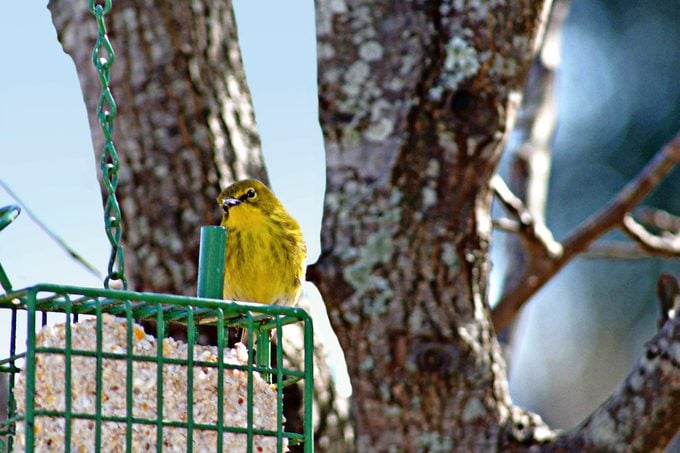How to Identify and Attract a Pine Warbler
Updated: Jun. 24, 2024
Learn how to identify and where to find a brightly colored pine warbler — one of the only warblers that will visit backyard bird feeders.
On This Page
Pine Warbler Identification

Identifying a pine warbler is a matter of getting a good look and finding it in its favorite habitat. With greenish olive backs and bright yellow underneath, and dark gray colored wings with two white wingbars and green-gray streaking on the sides, these birds can resemble other warblers at a quick glance. Females are duller than males.
Complicating identification, it’s often harder to identify first-year birds in fall. Dr. Pamela Hunt, Senior Conservation Biologist for Audubon New Hampshire, explains. “In the fall, they can be dull greenish olive,” she says. “You wouldn’t think they’re the same species.” Immature birds’ plumage can vary, with some showing yellow and others appearing gray or brown. Regardless of overall coloration, immature pine warblers show a white eyering.
Here’s how to identify yellow warblers and palm warblers.
Pine Warbler Range and Habitat

You can also identify this bird by its preferred habitat. As indicated by its name, look for pine warblers in groves of pines. Like other warblers, they are often spotted high in the treetops.
“You’ll be looking up at them, because they’re usually high up in the trees during summer,” Pamela explains. And while some warblers don’t typically visit backyards, pine warblers can appear in residential areas if the habitat is right for them. “They’re more likely to be in a yard, because they’ll be in residential pine trees and city parks, stuff like that,” Pamela says.

Pine warblers spend summer in portions of the eastern United States after migration, but they stick around year-round in Florida and elsewhere in the southeastern states. In summer, their range extends as far north as the southern edge of eastern Canada.
Pamela highlights that pine warbler populations are increasing. In some cases, they’ve even started to forgo migration in northern climates. “In New Hampshire, there were dozens of them that stayed around in winter because it was mild,” she says.
Pine Warbler Nesting Habits
Pine warblers usually nest in pine trees. A typical brood consists of three to five eggs, and both parents help with incubation. Young remain in the nest for about 10 days, and pairs raise two to three broods per season.
Pine Warbler Songs and Calls

To identify a pine warbler by ear, listen for a melodic trill that lasts for a few seconds. Ears-only identification can be difficult, because the pine warbler’s song is similar to that of the dark-eyed junco and the chipping sparrow. To differentiate them, Pamela says the pine warbler’s song is more musical.
Bird sounds courtesy of the Cornell Lab of Ornithology
Diet: What Do Pine Warblers Eat?

Unlike other warblers, pine warblers can be feeder birds. While they prefer to dine on insects such as spiders, caterpillars, and ants during the summer, when food is scarce, they’ll visit feeders.
“These are one of the few warblers that will eat seed,” Pamela says. “Pine warblers can’t open a sunflower seed, but they’ll eat a whole one. That predisposes them to wintering farther north than other warblers do.” In winter, they’ll also eat suet or mealworms.

“What is this yellow bird (above) that visits my feeder?” asks Birds & Blooms reader Christine Ramey of Springfield, Georgia.
Birding experts Kenn and Kimberly Kaufman say, “That’s a special visitor because it’s a member of the warbler family. And since warblers are insect eaters, most aren’t attracted to feeders. One main exception is the pine warbler. They regularly visit suet feeders, especially in the Southern states during winter. They also sometimes eat sunflower seed. This particular warbler is male. Key field marks include the bright yellow underparts with streaks at the sides of the chest, and the detailed pattern around and below the eyes.”
About The Expert
Pamela Hunt has worked with New Hampshire Audubon for more than 20 years. She holds undergraduate and graduate degrees in biology and zoology, and she earned her PhD from Dartmouth College in 1995. In her role as senior biologist for avian conservation, Pamela works with governmental organizations in the state to coordinate bird research and monitoring efforts.
Kenn and Kimberly Kaufman are the official bird experts for Birds & Blooms. They are the creators of the Kaufman Field Guide series and they lead birding trips all over the world.
Sources
- Audubon, “Field Guide: Pine Warbler“
- Cornell Lab of Ornithology, “Pine Warbler: Overview“























